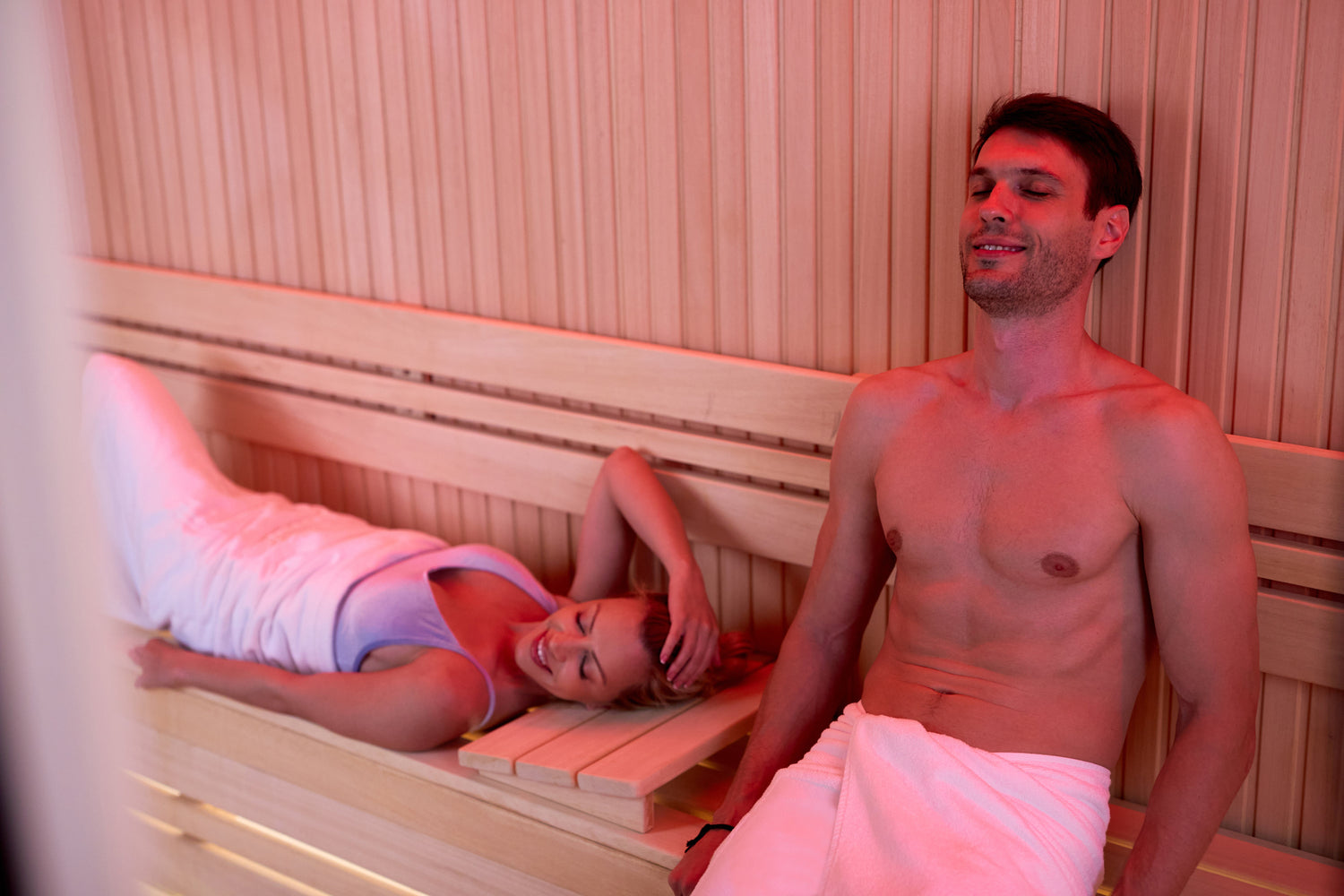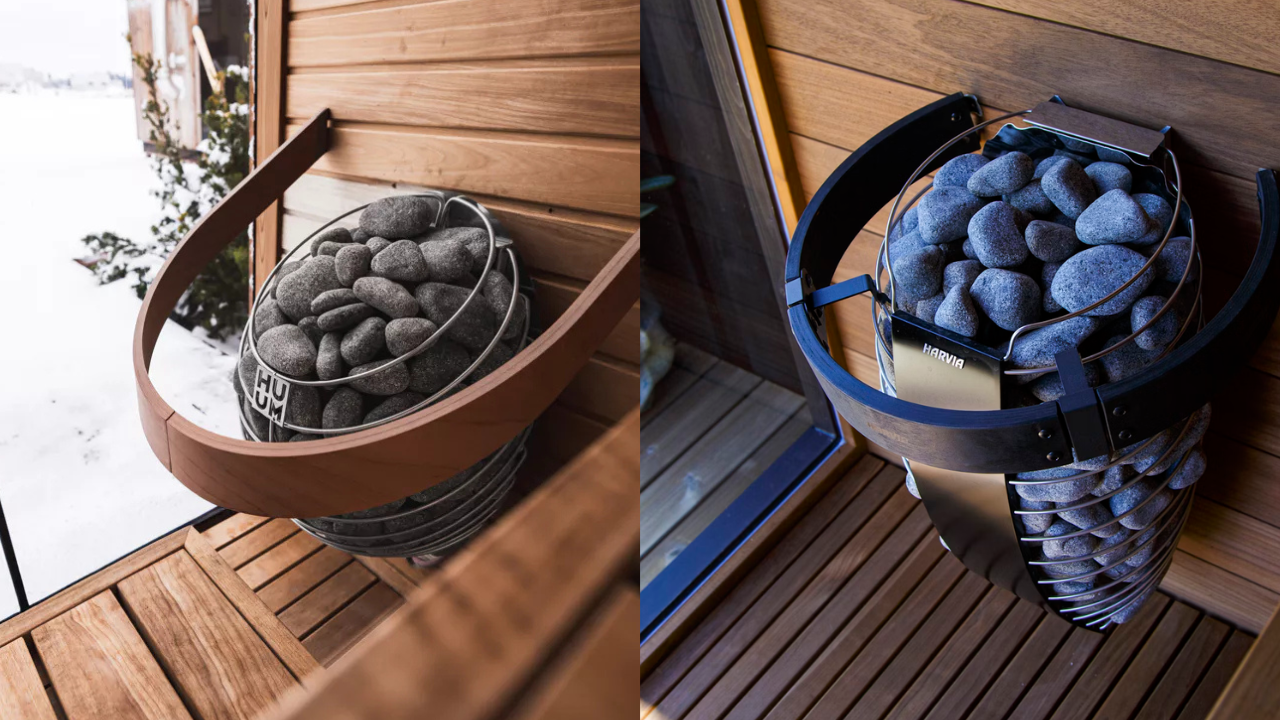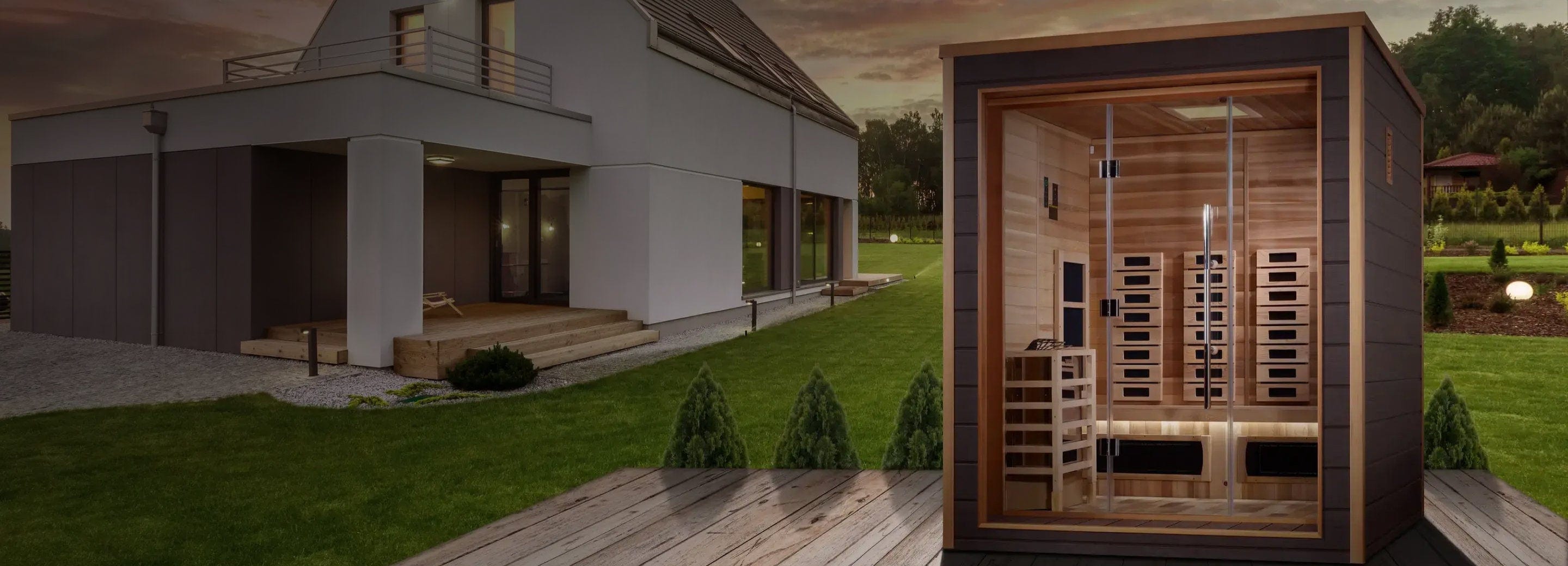Standing in the sauna aisle of your local wellness store or scrolling through countless online reviews, you’ve likely encountered terms like "near infrared," "far infrared," and "full spectrum" thrown around with the confidence of established science. Yet beneath the marketing claims lies a fundamental question affecting your daily wellness routine: Which type of infrared sauna delivers the therapeutic benefits you seek?
In this comprehensive guide, we’ll explore the science behind each wavelength, examine their distinct therapeutic applications, and help you determine which infrared sauna technology aligns with your wellness goals and lifestyle.
But before we get started:
What is an Infrared Sauna?
Unlike traditional Finnish saunas that heat the air around you using steam and hot stones, infrared saunas work by emitting invisible light waves that directly warm your body. This difference creates a more comfortable environment to experience therapeutic benefits at lower ambient temperatures.
Traditional steam saunas operate between 170-200°F with high humidity. Infrared saunas, conversely, maintain temperatures between 120-140°F while delivering therapeutic heat directly to your tissues. This gentle approach allows for longer, more comfortable sessions while promoting the deep sweating and cardiovascular benefits of heat therapy.
The technology behind infrared saunas uses specific wavelengths of light that fall just beyond the visible spectrum. These wavelengths are categorized into three distinct ranges:
- Near infrared (NIR),
- Mid infrared (MIR), and
- Far infrared (FIR).
Each wavelength penetrates your body to different depths, triggering unique physiological responses that contribute to overall wellness.
Let’s explore them in detail:
Types of Infrared sauna technology
1. Near Infrared Light
Near infrared light occupies the shortest wavelength range in the infrared spectrum, spanning from 0.75 to 1.5 micrometers. These wavelengths sit closest to visible red light, which explains why many near-infrared devices emit a subtle red glow during operation. This proximity to visible light gives near-infrared unique properties, and makes it effective for therapeutic applications.
Golden Designs Catalonia 8-person full spectrum near zero EMF far infrared ADA sauna
Near-infrared technology is often found in red light therapy devices, medical equipment, and specialized wellness tools.
How Near Infrared Works
Near infrared light penetrates your skin approximately 1 – 1.5inches, reaching surface tissues, blood vessels, and cellular structures. At this depth, the light interacts directly with mitochondria (the powerhouses of your cells), stimulating the production of adenosine triphosphate (ATP), which serves as the cellular energy currency.
This cellular stimulation triggers a cascade of beneficial responses. Blood flow increases to treated areas, bringing fresh oxygen and nutrients while removing metabolic waste products. The improved circulation supports your body’s natural healing processes and can accelerate recovery from minor injuries or intense workouts.
Health Benefits of Near-Infrared Saunas
The therapeutic benefits of near-infrared saunas center around cellular optimization and surface-level healing. Regular sessions can improve skin clarity, tone, and texture as the collagen production and improved circulation work together to rejuvenate your complexion.
Other benefits are:
- Heals wounds fast
- Supports muscle recovery
- Support cognitive function through improved cerebral blood flow
Ideal Use Case for Near Infrared Systems
Near-infrared saunas work best for individuals focused on cellular health, skin improvement, and targeted therapeutic applications. Near-infrared technology offers precise, effective treatment if you're dealing with specific skin conditions or minor injuries or seeking to optimize your body's natural healing processes.
2. Far Infrared Heat
Far infrared wavelengths in saunas span from 5.6 to 15 micrometers, placing them at the longer end of the infrared spectrum. These wavelengths generate the gentle, penetrating heat most people associate with infrared sauna therapy. Unlike near infrared’s focused light therapy approach, far infrared creates a comprehensive warming experience that affects your entire body.
The key characteristic of far infrared is its ability to heat your body directly without warming the surrounding air. This radiant heating method is similar to the warmth you experience from natural sunlight, creating a comfortable environment for extended therapy sessions.
How Far Infrared Saunas Work
Far infrared wavelengths penetrate 3-4 inches into your body, reaching deep tissues, muscles, joints, and internal organs. This deep penetration allows far infrared to raise your core body temperature, triggering many of the same physiological responses you’d experience during moderate cardiovascular exercise.
As your core temperature rises, your heart rate increases, and blood vessels dilate to help dissipate heat. This cardiovascular response can burn calories and improve circulation throughout your body. Deep heating also promotes profuse sweating, which is your body’s primary mechanism for cooling and detoxification.
The heating effect reaches muscles and joints, helping to relieve tension and reduce stiffness. Many users find that far infrared therapy helps alleviate chronic pain conditions, particularly those related to muscle tension or joint inflammation.
Health Benefits of Far Infrared Saunas
Far infrared saunas promote deep detoxification through intense sweating. As your core temperature rises, your body produces sweat containing water, electrolytes, heavy metals, chemicals, and other toxins stored in your tissues.
Other benefits are:
- Lowers blood pressure and improves overall heart health
- Provides pain relief and reduces symptoms for conditions like arthritis, fibromyalgia, and chronic muscle tension.
- Helps to manage weight
Ideal Use Case for Far Infrared Systems
If you want to support your body’s natural cleansing processes, improve cardiovascular health, or relieve chronic pain, far infrared technology offers the deep, penetrating heat you need.
Individuals with chronic pain conditions may also find far-infrared deep heating effects beneficial. The penetrating warmth can help relax tight muscles, reduce joint stiffness, and relieve pain beyond your sauna.
3. Full Spectrum Infrared Sauna
Full-spectrum infrared saunas combine near, mid, and far infrared wavelengths in a single system, delivering the complete range of therapeutic benefits associated with infrared therapy. These systems include specialized heaters that emit different wavelengths simultaneously or in programmed sequences.
Integrating multiple wavelengths means you receive both the targeted cellular benefits of near infrared and the deep heating effects of far infrared in every session. Mid-infrared wavelengths (1.5-5.6 micrometers) fill the gap between near and far, providing intermediate penetration depth and therapeutic effects.
Pros and Cons of Full-Spectrum Saunas
The primary advantage of full-spectrum systems lies in their versatility. You’d receive comprehensive therapeutic benefits without needing to choose between different wavelength ranges. This makes full-spectrum saunas particularly appealing for families or individuals with varied wellness goals.
The broader therapeutic range means you can address multiple health concerns simultaneously such as skin health, muscle recovery, detoxification, etc.
However, due to their complex heater technology, full-spectrum systems come with higher price points.
Who Should Buy Full-Spectrum Infrared Saunas?
Full-spectrum infrared saunas work best for individuals and families seeking comprehensive wellness benefits without choosing between different technologies. If you want to address multiple health goals simultaneously—such as skin health, muscle recovery, detoxification, and cardiovascular conditioning—a full-spectrum system provides the versatility you need.
Difference between Near Infrared vs Far Infrared Sauna
Near and far infrared differences lie in their wavelength characteristics and resulting therapeutic effects. Near infrared operates at 0.75-1.5 micrometers with shallow penetration (1-2 inches), while far infrared spans 5.6-15 micrometers with deep penetration (3-4 inches).
This penetration difference creates distinct therapeutic profiles. Near infrared excels at cellular optimization, skin health, and surface-level healing, while far infrared provides deep heating, detoxification, and cardiovascular conditioning.
The physiological responses also differ. Near infrared stimulates cellular energy production and improves circulation without significantly raising core body temperature. Far infrared raises core temperature, increases heart rate, and promotes intense sweating, which are responses more similar to moderate exercise.
Near vs Far: Which Should You Choose?
Your decision should consider your primary wellness goals, lifestyle preferences, and physical tolerance for heat therapy. Near infrared suits individuals seeking targeted, gentle treatment with specific cellular benefits. Far infrared works better for those who want comprehensive wellness support through deep heating and detoxification.
Also, consider your fitness level and heat tolerance when making your choice. Near infrared provides therapeutic benefits without raising your core temperature. This makes it perfect for people who are sensitive to heat, elderly users, or those recovering from injury.
On the other hand, far infrared generates a more intense, sweat-inducing session that mimics cardiovascular exercise. This is better suited for individuals who can comfortably tolerate higher temperatures and want to promote circulation, endurance, and detox through sweating.
Summary Table: Near Infrared vs Far Infrared vs Full Spectrum
|
Feature |
Near Infrared |
Far Infrared |
Full Spectrum |
|
Wavelength Range |
0.75-1.35 μm |
5.6-15 μm |
0.75-15 μm |
|
Penetration Depth |
2 - 5 inches |
1 - 1.5 inches |
Varies by wavelength |
|
Primary Benefits |
Cellular health, skin improvement, and wound healing |
Deep detox, cardiovascular health, and pain relief |
Comprehensive wellness |
|
Temperature Range |
Usually mild |
120-140°F |
100-140°F, depending on mode |
|
Best For |
Targeted therapy, skin health |
Deep heating, detoxification |
Versatile wellness |
How to choose an Infrared sauna
1. Size and Capacity
When choosing a sauna, consider how many people will use it and how often. A compact, 1-person infrared sauna is ideal for solo use, especially if your goal is targeted therapy or daily relaxation. These smaller units heat up faster and use less electricity, making them more energy-efficient.
Dynamic Barcelona 1 - 2 Person Low EMF FAR infrared sauna
On the other hand, if you plan to enjoy sauna sessions with a partner or family, a 2- to 4-person unit provides enough room for comfort and flexibility. Just remember, larger saunas require more physical space and longer heating times. Always measure your available area before deciding on the size.
2. Indoor vs Outdoor Placement
Placement is another critical decision that shapes your entire sauna experience. Indoor saunas are the most common choice and are easier to maintain, but they require adequate ventilation, nearby electrical outlets, and a level floor. The convenience of stepping directly from your bedroom or bathroom into a warm haven cannot be overstated, especially during winter when outdoor access becomes less appealing.
Outdoor saunas elevate the experience, turning your backyard into a private wellness sanctuary. Think about it: There’s something thrilling about moving from heated comfort into the crisp evening air, especially under starlight — wouldn’t you agree?
Outdoor saunas also have their cons.
Outdoor installations need added insulation, weather-resistant materials, and proper roofing or cover to protect against the elements.
You’ll also need to consider wiring outdoor models, sometimes a dedicated electrical circuit, or professional installation. Ultimately, your choice depends on your available space, local climate conditions, and how you envision integrating sauna sessions into your daily routine.
3. EMF Levels
EMF, or electromagnetic field exposure, varies between sauna models. While EMFs are a natural byproduct of electrical devices, some people are sensitive to them or prefer to limit their exposure during long sauna sessions. Many manufacturers now offer low-EMF or even zero-EMF infrared saunas that use special shielding, advanced carbon panel design, and strategic placement of electronics to minimize electromagnetic radiation. You can shop these variants on our website.
Maxxus 2-person near zero EMF Far infrared sauna
If you plan frequent sauna use or sessions longer than 30 minutes, low-EMF models can offer peace of mind and a more natural therapeutic environment. The difference is particularly noticeable for those who experience headaches or fatigue from electromagnetic exposure.
Look for models that measure EMF levels at typical sitting positions rather than just at the panels themselves. Always check for third-party EMF testing or verified emissions levels before purchasing.
4. Construction and Materials
Build quality greatly affects your sauna’s performance, safety, and lifespan. Look for models crafted from natural, untreated wood like Canadian Hemlock, Red Cedar, or Basswood. When heated, these woods are naturally durable, moisture-resistant, and emit minimal off-gassing, creating a cleaner air environment during your sessions. Cedar, in particular, offers natural aromatherapy benefits with its subtle, calming scent that induces relaxation. For example, this Maxxus 2-person near zero EMF Far infrared sauna is made from red cedar, which gives it a rich, rustic appearance that complements any space:
Pay attention to wood thickness, too. Panels should be at least 8mm thick for proper insulation and structural integrity. Double-wall construction with insulation between layers significantly improves heat retention and energy efficiency.
5. Heating Technology and Panel Types
The heart of any infrared sauna lies in its heating technology. Carbon fiber panels represent the gold standard, providing even heat distribution and a longer lifespan than older ceramic rod systems.
Full-spectrum heaters that emit near, mid, and far-infrared wavelengths offer the most comprehensive therapeutic benefits:
- Near-infrared for skin health
- Mid-infrared for circulation, and
- Far-infrared for deep tissue penetration and detoxification.
Panel placement also affects your experience. Look for models with heaters positioned at the back, sides, legs, and feet to ensure 360-degree coverage. Some premium models include adjustable panels that let you customize heat intensity for different areas of your body.
8. Safety Features and Certifications
Safety should never be compromised in your pursuit of wellness. Look for saunas certified by recognized testing laboratories like ETL, CSA, or CE, which verify electrical safety and construction standards. These certifications ensure your sauna meets strict home-use safety requirements and often satisfy insurance and warranty requirements.
Essential safety features include:
- Automatic shutoff systems activate if the sauna overheats or the door is left open.
- Ground fault circuit interrupters (GFCI) protect against electrical hazards in moisture-prone environments.
- Proper ventilation systems prevent moisture buildup and ensure fresh air circulation during longer sessions.
- Door locks should be easily operable from the inside with emergency release mechanisms if you experience discomfort during sessions.
- Temperature limiting controls prevent the sauna from exceeding safe operating temperatures.
Final Thoughts: Which Infrared Sauna is Best for You?
The choice between near infrared, far infrared, and full spectrum saunas ultimately depends on your wellness goals, heat tolerance, and lifestyle preferences. Each technology offers distinct advantages that align with different therapeutic objectives:
- Choose near infrared if you’re primarily interested in skin health, cellular optimization, wound healing, or targeted therapy applications.
- Choose far infrared for comprehensive wellness support, deep detoxification, cardiovascular conditioning, and chronic pain management.
- Consider full-spectrum systems if you want versatility and comprehensive benefits, have a family with diverse wellness needs, or prefer having multiple therapeutic options.
Ready to purchase your first unit? Check out our top picks from this infrared sauna collection or contact our experts for a personalized recommendation.




